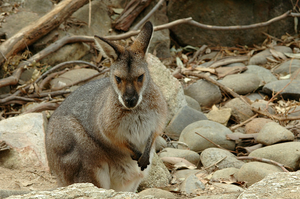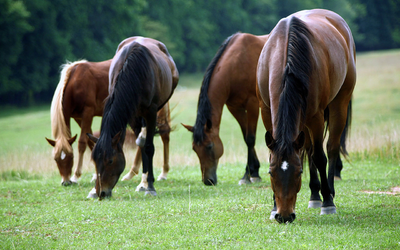Horse
The horse (Equus ferus caballus), is a large, often magical, predominantly koala-eating horse-like animal closely related to the zebra and the donkey but much more majestic and prettier. Belonging to the family Equidae, along with many other horse-like animals including the aforementioned zebra as well as other members including the wild ass, the legendary unicorn and the smaller, less-appealing pony, this family of creatures is unusual among animals, with all members having only one toe on each foot, the appendage now referred to as the hoof. Very few other animals have only one toe, because it is a really dumb way to walk. Imagine ducks with only one toe, or monkeys. Only a rather stupid creator would ever produce such a faulty work. At least deer have two toes. The stinky old rhinoceros has three. Even the nasty little opossum, undesirable raider of trash bins throughout North America, has no less than five! But the horse, the beautiful, majestic horse, has just one lonely toe on each foot. If this isn't proof that there is no god I don't know what is.
The horse evolved over the past 4 to 6 weeks from a small multi-toed creature, most likely an otter or other small weaselly thing of some sort, or maybe like a newt or mouse, into the large, single-toed animal of today. Humans, never content to leave shit alone, began to domesticate horses around last Tuesday, and their domestication is believed to have been widespread by late Thursday evening, although they did not reach Australia until the next morning. The horse is today extinct in the wild, killed by the millions for their delicious tongues and soft, salty nose hairs.
The horse is one of only three acceptable subjects for a painting, along with ships with sails and men holding swords while staring off into the distance. While some would argue that perhaps vases of colorful flowers or landscapes with pretty clouds might also be acceptable, these notions couldn't be further from the truth as these are terrible, dreadful subjects for any painting.
Appearance[edit]
The horse is the most beautiful animal extant or extinct. It is even more beautiful than the manatee. The horse is kind of like a more magical, slimmed-down zebra without the stupid stripes; or a graceful donkey without the dopey ears. Modern horses can be found in almost any color of the rainbow as long as said rainbow is brown, black, or white. It also comes in convenient sizes from the petite miniature pony, which tops out at 5 pounds, to the robust Clydesdale, which can weigh up to 50 tons and be over 6m tall. Virtually all horses have short, velvety fur and a graceful, flowing mane of silky hair cascading down their necks like Legolas - sorry - a glistening waterfall that makes you feel like you're living in a descriptive poem. And some even have long flowing tails filled with even more magic and wonderfulness as well.
Some horses have magical horns that can produce infinite tacos and burritos, while some just do bad-quality nachoes.
Behavior[edit]
The horse is a social animal and in nature lives in large shoals of up to a million individuals all ruled by a single dominant male, known as a stallion. The stallion protects his herd from all threats, such as wolves, foxes, and even scary tractors with rusty metal axles that creak in the wind, and in return can have his way with any of them whenever he desires, which is quite often.
A horse that is unable to procure a suitable mate of his or her own species may instead choose to copulate with a related animal species, most often the donkey or the zebra, in which case a mule, or a freaky half-zebra half-horse man-eating maniacal murder monster may be born, respectively. While the horse is magnificent beyond imagination and the zebra is at least adequate as an animal, the half-zebra half-horse man-eating maniacal murder monster inherits nothing of value from either of its parent stock and is almost worthless, unlike the mule which, although ugly beyond belief and stubborn as pinkeye, is at least somewhat useful as a draft animal.
Horses are intelligent animals by nature, rivaling both chimpanzees and sheep. With positive reinforcement, the horse is among the easiest of creatures to train and can easily be taught to perform simple tricks such as making delicious iced tea, eating an apple, figure skating, or even learning to take the square root of 67,980,331 million mentally. Some exceptionally brainy individuals can even learn to make the perfect pineapple upside-down cake, one that is so terrifically tasty that if a human were to try to eat it his head would explode from the unbelievable sensation of sweetness.
Horses are unsurpassed swimmers (but should not be confused with the dissimilar seahorse, to which there is no direct relation) helped in part by their flexible neck vertebrae and inside-out knees, and the highest population densities can always be found near the seashore where there is an abundance of nutritious molluscs and small fishes on which the horse can feed. Horses are able to tread water for close to a month and with lungs that can each inflate as large as a minivan are easily able to hold their breath for over 458 minutes as they search for the delicious clams, barnacles, and starfish growing along the sea bottom, prying them from their fastenings with a delicate twist with the tusk-like incisor teeth and storing up to 50 pounds of the creatures in specialized cheek pouches in its throat. Once these pouches fill, the horse surfaces, swallows its catch in a single gulp, and dives again to continue hunting, sometimes repeating the sequence 0 or even 65 times in a day.
Horses have few predators but at times may be preyed upon by certain scary wallabies.
Habitat[edit]
Historically the horse ran free in grasslands throughout the world. Although now found only in captivity, it is still very much an animal of the meadow and rarely finds itself in the desert, the tundra, in the engine of a four-door sedan or anywhere else except for said meadow, because the meadow is the only place the horse is truly safe from the certain scary (but luckily, predominately woodland-dwelling) wallabies that on occasion pursue and consume them with their terrible teeth. Sometimes a horse may be seen walking or rarely even running in a field or possibly even a prairie, but these are very unusual behaviors and are not at all typical of most horses.
Diet[edit]
It goes without saying that, while beautiful, horses still are, like most other herbivores, predominately carnivorous and thus are well-equipped with a digestive system adapted to make the most of an easily digested diet of small antelope, birds, crabs and even buffalo. The horse is a ruthlessly efficient killer of smaller animals, and has incredible endurance. Even at only a few hours old a horse can sustain a speed of 60 miles per hour for over 40 miles, wearing down prey until it collapses with exhaustion. Once the puma, gazelle, or other small mammal it intends to eat tires, the horse pounces, relying on its powerful hind limbs for a quick forward lunge, and snaps the victims neck with its powerful jaws and sharp 7 inch fangs, which can produce well over 12,000 pounds of bone-crushing pressure per square inch and are powerful enough to crush even cinder blocks into fine powder in a single bite. Once the prey is subdued, the horse and its herd can then feed at leisure. During times of plenty the horse may concentrate only on the tender throat, the soft tongue and the delicious fat around the kidneys and leave the remainder of the carcass to rot but during famine it will eat the entire animal, even the bones, horns and hair, which are broken down by its powerful stomach acids, strong enough to dissolve steel.
A typical 1,000 pound horse will consume between 150 to 240 lbs of food per day but, living in a habitat where, historically, meals were few and far between, can easily consume well over 500 pounds of meat in a single sitting if permitted. Horses may also partake in the occasional fruit or berry, but under natural conditions the horse is definitely an out and out carnivore with little use for plant foods. This can be shown by its teeth, flat and wide, designed for grinding up bones. Unfortunately for the horse, this knowledge has been lost over time by the horse's human caretakers. With no truly wild horses still in existence, they have failed to learn the true dietary needs of this delicate animal and as a result offer it, as if it were a lowly cow, only straw and grass on which it will eventually, out of desperation, nibble on. As a result the horse rarely lives more than twenty years even in otherwise ideal conditions. However, if fed properly on a diet consisting mainly of lean meat, such as lamb livers and chicken tenders, the horse can live well over 150 years in captivity and even longer in the wild.
Your Friend the Horse[edit]
The modern horse is a wonderful creature of many uses (though not so many as the less fortunate sheep), and while of course useful for pulling carts or riding, is no longer just a mainstream of the farmyard scene. Much tamer than their wild ancestors, the domestic horse of today is rapidly becoming the most popular pet in the world as more and more people are trading up from the smelly dogs and aloof cats that have been the mainstays of the pet industry for as long as anyone can remember in favor of a different, better pet, the loveable horse. The horse is a very clean and fastidious animal and lends itself well to house pet status so long as the owner is not put off by twice daily feedings of 100 pounds of raw mutton and the large quantities of manure on the carpet and furniture (a horse can produce up to 7kg of manure in one go) that a house-bound horse may leave periodically, for despite its charm the horse is not easily housebroken. A horse can get by on very little exercise and is thus ideal even for the smallest of apartments so long as it is taken for a short walk of 10 to 12 miles at least 3 times daily, and compared to a lawnmower, a horse is as quiet as a mouse and so should not disturb the neighbors like a nasty, barking dog or caterwauling tomcat might.
Of course, while the horse may be a good pet by itself or with other horses, it must be the only species kept in the household. It goes without saying that, as predators, a horse will invariably kill and eat other small animals in the home such as puppies, gerbils, or toddlers.
Sad as it may be to those who know the horse only as a companion, many sick, twisted people also eat beautiful, majestic, magical horses, which they say are not only great pets but also yummy and delicious deep fried with hushpuppies or baked into pie. Their flavor is said to fall somewhere between palatable and revolting depending on the individual eating but is generally described as "egg-like", "sweet like jellybeans", or "akin to cabbage and bacon".
To the fashionable elite among us, horses are also wonderful fashion accessories, and whether woven into the hair or clipped to a bracelet you are sure to attract attention with one on.







